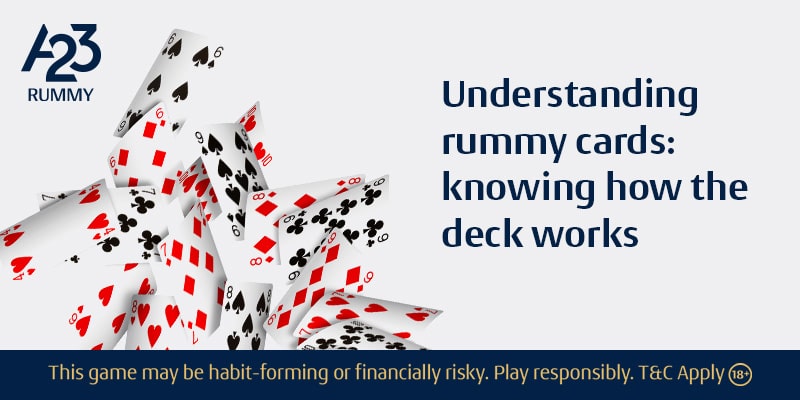One of the most popular card games, rummy, is played with one deck (sometimes two) and two jokers. One of the decks is a closed pile of cards, whereas the other is an open pile of discarded cards.
The jokers make the game even more interesting by adding a little spice to it and a fun challenge. The players in the game are given 13 cards, and the first one to complete the game’s objective declares their wins and shows their sequence.
If you are new to the game and looking for an easy explanation of how to play Rummy and how the Rummy cards work, here is one. Read the blog to understand cards in Rummy better.
Objective of the Rummy Game
Every player gets 13 cards in Rummy in the beginning, and the main objective of the game is to make (or meld) a minimum of two sequences. The combination of these melds can be:
- Sequences (or Runs): It is a consecutive sequence of three or more Rummy cards of the same suit.
- Sets (or books): This is a sequence of three or four cards of the same rank.
To make a winning sequence, one out of the two sequences has to be a pure sequence, and the other one can either be a valid run or a set with a Joker. If you have two sequences, but neither of them is a pure sequence, you cannot declare a win with your rummy cards.
Understanding Rummy Cards
It is essential to understand how the cards in Rummy work and what their order is to form the right sequences. If you understand their orders, you can accurately analyse your opponent’s hand and their possible sequences.
Additionally, you cannot develop winning strategies without understanding Rummy cards. This will help you understand your opponents’ moves and make better decisions about keeping and discarding Rummy cards.
So, let us understand the cards in Rummy better:
- A standard deck of Rummy cards comprises 52 cards with two colours: red and black.
- Furthermore, the deck is divided into four suits, each with 13 cards: Diamonds, Hearts, Clubs and Spades.
- There are two Jokers in the deck that are drawn at random from the cards in Rummy.
- The order of the cards in Rummy (from highest to lowest) is: Ace, K, Q, J, 10, 9, 8, 7, 6, 5, 4, 3, 2.
- The game begins with every player getting a fixed number of cards in Rummy. The remaining cards in the deck become the draw pile.
- Next, you arrange the Rummy cards in the right order so that it is easier to form strategies and plan moves to form the desired sequences.
- Once it is your turn, you can either draw a fresh card from the draw pile or pick the last discarded card if it fits your goal.
- This goes on until one of the players in the game melds the necessary sequences and makes a Rummy declaration.
Types of Rummy Card Sequences
There are three types of sequences you can form/meld with the Rummy cards to form a winning sequence. They are as follows:
Pure Sequence:
This sequence is essential to make a valid Rummy declaration. It is made of three or more consecutive cards of the same suit and cannot have a Joker in it.
For example, 5♥ 6♥ 7♥ makes a pure sequence.
Impure Sequence:
An impure sequence can be the second sequence of your winning sequences. It has three or more consecutive cards of the same suit, with Joker used as a replacement for a missing card.
For example, 5♥ 6♥ and a Joker is an impure sequence.
Sets:
As mentioned above, a set is a sequence of three or four cards in rummy of the same rank and can have a Joker if required.
For example, A♥ A♣ A♦ is a valid set.
Conclusion
Winning a Rummy game requires you to understand the rules listed in our rummy guide thoroughly. Once you have a clear understanding of how the cards in Rummy work, you can put them to the best of your ability and increase your chances of winning.


